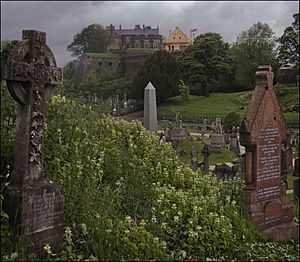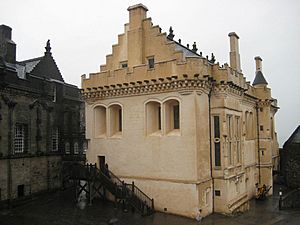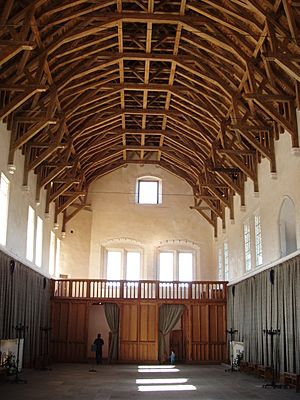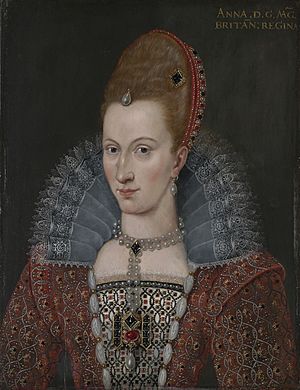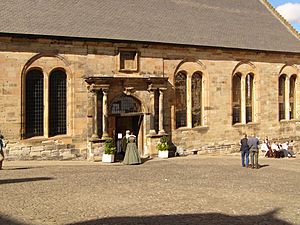Masque at the baptism of Prince Henry facts for kids
The masque at the baptism of Prince Henry was a big celebration held on August 30, 1594, at Stirling Castle in Scotland. It marked the christening of Prince Henry, the first child of James VI of Scotland and Anne of Denmark. This event was very important because Henry was next in line to the Scottish throne, and later, the English throne too.
The celebration included a special performance called a masque, written by Scottish poets William Fowler and Patrick Leslie, 1st Lord Lindores. William Fowler also wrote a book about the event called A True Reportarie of the Baptisme of the Prince of Scotland. The party was inspired by grand festivals from other European royal courts. It featured a tournament where knights wore unusual costumes, and a masque during which sweet desserts were served. There were also Latin sayings displayed and songs performed. A main part of the show was a ship filled with sugar fish, which represented Queen Anne's safe sea journey to Scotland in 1590. This journey was seen as a victory over "witches" and bad weather. King James VI was even called a "new Jason" from Greek myths, and Queen Anne was compared to Medea and the valuable Golden Fleece. The whole event was delayed because a new Chapel Royal at Stirling Castle, designed by William Schaw, wasn't finished, and they were waiting for the English ambassador to arrive.
Contents
Getting Ready for the Party
Preparations for the big event began in December 1593. Workers were ordered to fix up the palace at Stirling Castle for the queen, who was expecting her baby. Some people thought Edinburgh Castle would be a safer place for the queen.
Queen Anne first stayed in other houses near Stirling until the castle was ready. Prince Henry was born on January 19, 1594, and everyone celebrated with bonfires. King James VI even wrote to Elizabeth I of England, asking her to be a godmother. New clothes were bought for the king's old nurse, Helen Littil, and her daughters, who were invited as guests.
Ambassadors from Queen Anne's family arrived in Scotland in July 1594. The queen went to Falkland Palace to avoid meeting them at Holyrood Palace in Edinburgh, as it wasn't grand enough for such important guests. The main reason for the delay was that the new Chapel Royal at Stirling, sometimes called the "great Temple of Solomon," wasn't finished. The celebrations were put off until Stirling Castle was ready and the English ambassador arrived on August 28. Sadly, a hard-working administrator named Alexander Hay died from exhaustion after the events were over.
Exciting Tournaments at the Castle
The first big event was a competition called "running at the ring." This is where riders on horseback try to catch hoops with their lances or spears. There were three teams: one dressed as Christian Knights of Malta, one in Turkish style, and three men dressed as Amazons (fierce female warriors from myths). A fourth team, meant to be dressed as Africans, didn't show up. The competition happened in the valley next to the castle. Queen Anne and her ladies, along with the ambassadors, watched. A large crowd of young men from Edinburgh, armed with muskets, also came to watch.
The "Christian Knights" included King James VI himself. The "Turks" team included the Duke of Lennox. The "Amazons" team included Lord Lindores. Each team had special symbols or designs related to the festival's themes. Queen Anne gave diamond rings to the winners, led by the Duke of Lennox.
Some people were not happy about the king and his friends dressing as Catholic "Knights of the Holy Spirit." But the idea was probably to show Protestants winning against "Turks," who represented the Catholic church at the time.
A planned event for the second day was cancelled because the costumes and props weren't ready. This event would have featured knights riding on amazing creatures like a lion, elephant, unicorn, gryphon, hydra, crocodile, and a dragon.
The Baptism Ceremony
The third day, August 30, was the actual baptism in the Chapel Royal. Queen Anne of Denmark doesn't appear in the accounts of the ceremony, so it seems Annabell Murray, Countess of Mar took her place. Records show how the chapel was set up, with the king's seat and nine seats for ambassadors having cushions and special cloths made of ten different colours of velvet. King James sat on a pink velvet cushion with silver embroidery. The English ambassador, the Earl of Sussex, carried Prince Henry into the chapel in a procession under a special canopy. The canopy was held by four important Scottish lords. Young men from Edinburgh, dressed in armour with muskets, lined the path from the palace to the chapel.
Inside the chapel, the Earl of Sussex handed the baby to the Countess of Mar. Two bishops gave sermons, and musicians sang a psalm. After the baptism, Prince Henry's name, "Henry Frederick," was announced from a window of the Great Hall to the crowd outside, with trumpets blowing loudly. The prince was carried back to the palace, and all the cannons in the castle fired a salute.
Later, in the queen's inner hall in the Palace, Prince Henry was made a knight and crowned as a duke by his father. He was given many important titles, including Duke of Rothesay and Lord of the Isles.
After this, several Scottish men were made knights in the queen's outer hall. Their names were announced from the palace terrace with trumpets, and gold coins were thrown to the people in the garden below. Then, Queen Anne received the gifts that the ambassadors had brought.
The Big Feast and Masque
The supper or feast started at 8 o'clock that evening. The new knights served the first course. For the second course, a table full of desserts like pastries, fruit, and sugar sweets was pulled into the Great Hall. Six young women, probably Queen Anne's ladies-in-waiting, were part of this display. They were dressed in beautiful silver and crimson satin costumes, decorated with gold and silver, and wore crowns with feathers, pearls, and jewels in their hair. They represented ideas like Ceres (goddess of farming), Fecundity (fruitfulness), Faith, Concord (agreement), Liberality (generosity), and Perseverance.
William Fowler called this a "silent comedy." He explained that they had planned for a real lion to pull this table, but they worried it might scare the guests or get startled by the bright lights. So, instead, an African man, whom Fowler called "the Moore," appeared to be pulling the scene with golden chains. In reality, hidden ropes and mechanisms moved it.
This idea of an African actor replacing a lion might have inspired a scene in Shakespeare's play A Midsummer Night's Dream, which was written soon after. In the play, characters worry about a lion scaring the ladies, and one says, "God shield us! a lion among ladies, is a most dreadful thing."
After the dessert table was moved away, a large model ship was brought into the Great Hall. This ship was meant to remind everyone of King James's journey to Norway and Denmark in 1589 to meet Anne of Denmark. It was like the story of Jason and the Argonauts. The ship had Neptune, the god of the sea, as its pilot, suggesting he helped their marriage happen despite "witches" trying to stop them. The ship's sails showed a compass, the North Star, and the coats of arms of Scotland and Denmark. Other mythical figures like Thetis and Triton were on board, along with sailors and musicians. Three women dressed as mermaids sang and mimed. The ship had 36 working brass cannons!
The ship was loaded with all sorts of fish made from sugar, like herring, oysters, and crabs. These were served in blue Venetian glasses while Arion played his harp on a dolphin. Latin songs praising Queen Anne were sung, followed by a psalm. Then, Triton blew his trumpet, Neptune whistled, and the ship sailed away, firing its cannons.
William Fowler explained that the ship's theme was King James's own idea, celebrating his brave sea journey to bring his queen to Scotland, overcoming "witches" and "devilish dragons." This model ship was kept in the Chapel Royal for many years.
After this, James, Anne, and the ambassadors went to another room in the Palace, decorated with tapestries, for another banquet of sugar sweets. The Great Hall was then cleared for dancing and other fun, which lasted until 3 in the morning! Over the next few days, King James gave gifts to the ambassadors.
Ambassadors and Their Gifts
Robert Radclyffe, 5th Earl of Sussex was the ambassador from England. He carried Prince Henry into the chapel during the baptism. After discussing Scottish politics with King James, Sussex left Scotland.
Sir James Melville, a gentleman in the queen's household, described how Queen Anne received the ambassadors' gifts. She spoke to the English, Danish, and German ambassadors in their own languages. She asked Melville to translate her French into French for the Dutch ambassadors. The ambassadors gave Queen Anne gifts of jewellery, which she then passed to Melville to put back into their special cases. This gift-giving was a bit of a competition, with each country trying to show off its wealth and importance. The Earl of Sussex said the gifts were "the most stately presents that ever they saw."
Queen Elizabeth of England sent gifts of silver and gold items, some of which were very old and valuable. The Danish ambassadors brought gold chains for the queen and prince, one with "CHRISTIANUS" spelled out in diamonds. An ambassador from Brunswick brought a gold chain with pea-pods and a locket with a miniature portrait of the Duke of Brunswick. An ambassador from Mecklenburg brought a necklace of rubies and other jewels for the queen, and a miniature portrait of the Duke of Mecklenburg surrounded by diamonds for Prince Henry.
The ambassadors from the Dutch Republic gave two large gold cups and a letter promising Prince Henry a yearly payment of 5,000 "Gelderlings." Sir James Melville was very impressed by how heavy these gold cups were.
In return, King James VI gave the ambassadors gifts in the days after the baptism. For example, the Earl of Sussex received a set of silver-gilt plates. The ambassadors left in three large ships, with 60 cannon shots fired as they departed.
Stirling Castle Today
The buildings at Stirling Castle where these events happened are still standing today, looking much like they did in 1594. The insides of the Great Hall, Chapel Royal, and Palace have been restored to their original look. The Chapel Royal was specially built for the baptism by William Schaw, the king's Master of Work. It was designed in an Italian style, and its measurements were meant to match the Temple of Solomon from the Bible. King James VI was often compared to Solomon by his courtiers.
Today, visitors can still explore and experience these historic spaces at Stirling Castle.
Important People Made Knights
After the baptism ceremony, several Scottish men were made knights in the queen's outer hall of the Palace. Their names were announced from the palace terrace with trumpets, and gold coins were thrown to the crowd below. Some of the new knights included:
- Andrew Balfour of Strathure
- John Boswell of Balmuto
- Robert Bruce of Clackmannan
- Walter Dundas of Over Newliston
- George Elphinstone of Blythswood
- Alexander Fraser of Fraserburgh
- John Lindsay of Dunrod
- William Stewart of Houston
- Sir John Wemyss of Wemyss
Images for kids
-
Prince Henry was carried from the Queen's Audience Chamber or Inner Hall to the Chapel Royal by Robert Radclyffe, 5th Earl of Sussex.


